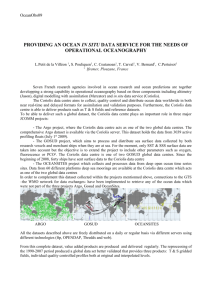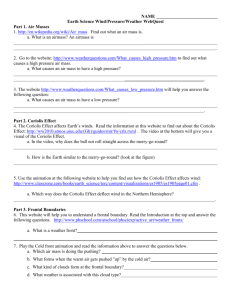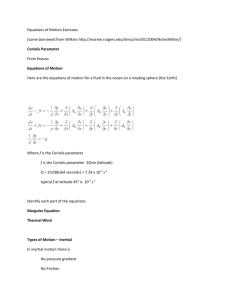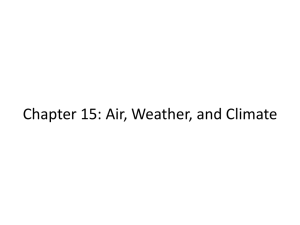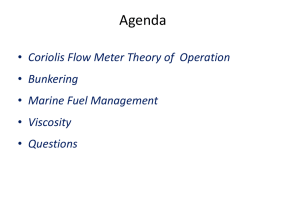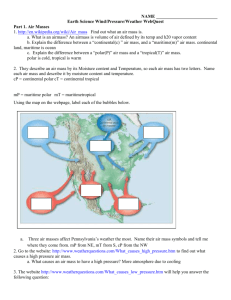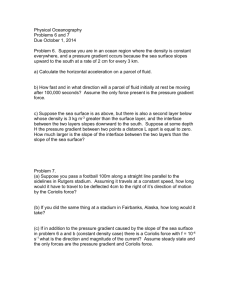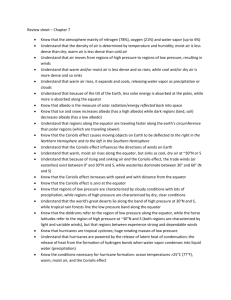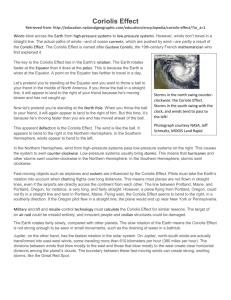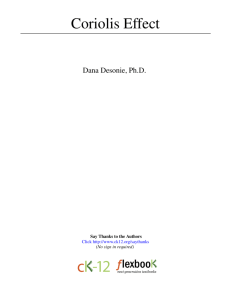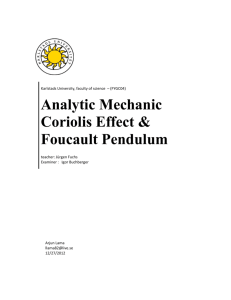WebQuest: Wind and Weather
advertisement
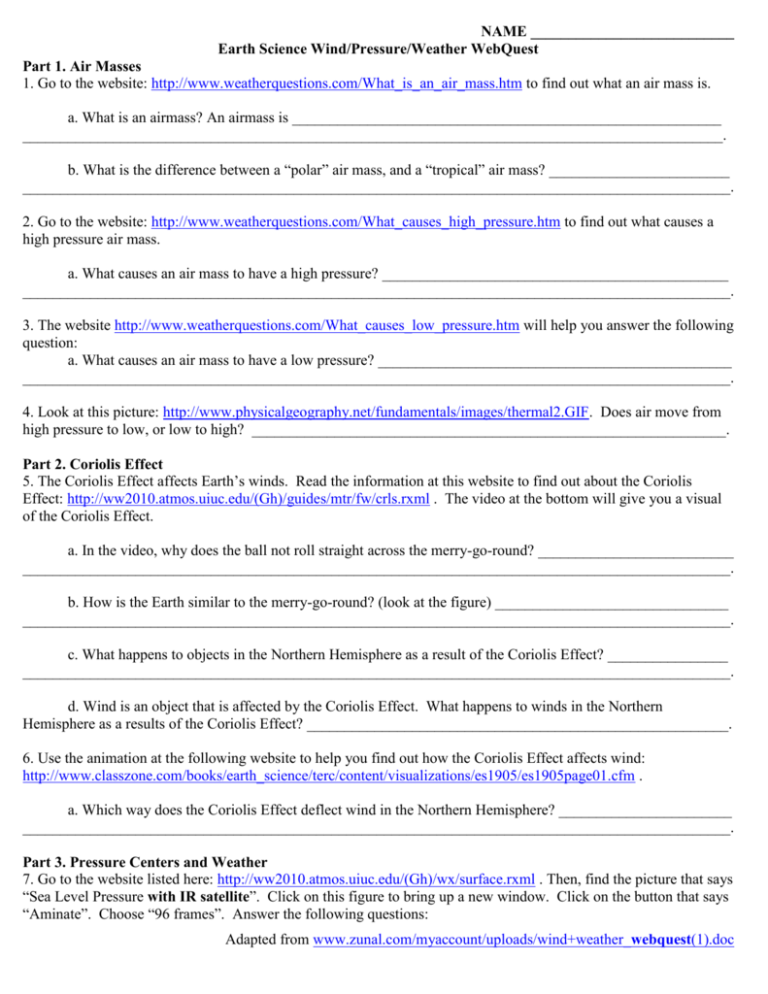
NAME ___________________________ Earth Science Wind/Pressure/Weather WebQuest Part 1. Air Masses 1. Go to the website: http://www.weatherquestions.com/What_is_an_air_mass.htm to find out what an air mass is. a. What is an airmass? An airmass is _________________________________________________________ _____________________________________________________________________________________________. b. What is the difference between a “polar” air mass, and a “tropical” air mass? ________________________ ______________________________________________________________________________________________. 2. Go to the website: http://www.weatherquestions.com/What_causes_high_pressure.htm to find out what causes a high pressure air mass. a. What causes an air mass to have a high pressure? ______________________________________________ ______________________________________________________________________________________________. 3. The website http://www.weatherquestions.com/What_causes_low_pressure.htm will help you answer the following question: a. What causes an air mass to have a low pressure? _______________________________________________ ______________________________________________________________________________________________. 4. Look at this picture: http://www.physicalgeography.net/fundamentals/images/thermal2.GIF. Does air move from high pressure to low, or low to high? _______________________________________________________________. Part 2. Coriolis Effect 5. The Coriolis Effect affects Earth’s winds. Read the information at this website to find out about the Coriolis Effect: http://ww2010.atmos.uiuc.edu/(Gh)/guides/mtr/fw/crls.rxml . The video at the bottom will give you a visual of the Coriolis Effect. a. In the video, why does the ball not roll straight across the merry-go-round? __________________________ ______________________________________________________________________________________________. b. How is the Earth similar to the merry-go-round? (look at the figure) _______________________________ ______________________________________________________________________________________________. c. What happens to objects in the Northern Hemisphere as a result of the Coriolis Effect? ________________ ______________________________________________________________________________________________. d. Wind is an object that is affected by the Coriolis Effect. What happens to winds in the Northern Hemisphere as a results of the Coriolis Effect? ________________________________________________________. 6. Use the animation at the following website to help you find out how the Coriolis Effect affects wind: http://www.classzone.com/books/earth_science/terc/content/visualizations/es1905/es1905page01.cfm . a. Which way does the Coriolis Effect deflect wind in the Northern Hemisphere? _______________________ ______________________________________________________________________________________________. Part 3. Pressure Centers and Weather 7. Go to the website listed here: http://ww2010.atmos.uiuc.edu/(Gh)/wx/surface.rxml . Then, find the picture that says “Sea Level Pressure with IR satellite”. Click on this figure to bring up a new window. Click on the button that says “Aminate”. Choose “96 frames”. Answer the following questions: Adapted from www.zunal.com/myaccount/uploads/wind+weather_webquest(1).doc a. This map shows you isobars and cloud cover. What is an isobar? _________________________________ ______________________________________________________________________________________________. b. Look at the map and find Chicago. Between which two isobars is Chicago? ________________________. c. Press “Play” on the window, and watch where the clouds travel. Do the clouds tend to be near High pressure centers (H) or Low pressure centers? ________________________________________________________. 8. This last website will help explain why High pressure centers usually mean good weather, and Low pressure centers usually mean bad weather: http://www.usatoday.com/weather/tg/whighlow/whighlow.htm . Go here and read to discover why this is true, and then answer the following questions: a. Air descends (comes down) at High pressure areas. Why does descending air not allow for clouds to form? ______________________________________________________________________________________________. b. Air ascends (goes up) at Low pressure areas. Why does ascending air allow for clouds to form? _________ ______________________________________________________________________________________________. Part 4. Synthesis Your last task is to synthesize all of the information that you have just learned. Yu will have two ways to demonstrate your knowledge: a labeled diagram (that you create, not copy from a website), or a written summary of what you have learned. In your diagram or summary, you need to show me that you know the following things: 1) what is an air mass? 2) What happens at a low pressure center, and what happens at a high pressure center? 3) How does the Coriolis Effect affect wind? and, 4) why is good weather associated with high pressure centers, and bad weather with low pressure centers? Rubric for Part 4: Category 1. What is an air mass? (3 points) 2. Low pressure and high pressure centers (5 points) 3. Coriolis Effect (4 points) 4. Effect on weather (5 points) 5. Neatness and Grammar (3 points) Excellent Work Average Work Developing Work Student fully Student somewhat Student does not demonstrates what an demonstrates what an demonstrate what an air mass is (3 points) air mass is (2 points) air mass is (0 points) Student fully Student somewhat Student does not demonstrates what demonstrates what demonstrate what low low and high pressure low and high pressure and high pressure centers are (5 points) centers are (3 points) centers are (0 points) Student fully Student somewhat Student does not demonstrates what the demonstrates what the demonstrate what the Coriolis Effect is (4 Coriolis Effect is (3 Coriolis Effect is (0 points) points) points) Student fully Student somewhat Student does not demonstrates what the demonstrates what the demonstrate what the effect on weather is (5 effect on weather is (3 effect on weather is (0 points) points) points) The summary/diagram The summary/diagram The summary/diagram is very neat and is somewhat neat and is not neat nor grammatically correct grammatically correct grammatically correct (3 points) (2 points) (0 points) Your Score Adapted from www.zunal.com/myaccount/uploads/wind+weather_webquest(1).doc
